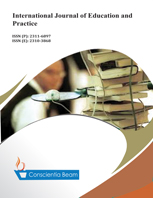The Role of Experiential Learning and Engineering Design Process in K-12 Stem Education
DOI:
https://doi.org/10.18488/journal.61.2020.84.720.732Abstract
The STEM education emphasizes on Science, Technology, Engineering and Mathematics with a major focus on engineering design process that engineers require in solving challenges or problems. Kolb's model provides micro-learning activities such as experiencing, sharing and processing, generalizing and applying. Therefore, both Kolb’s model and engineering design process are indispensable in K-12 STEM education. The K-12 STEM curriculum provides and guides students to complete a series of experiential tasks in engineering design process. Kolb's model explains how Science, Technology, Engineering and Mathematics are connected and integrated in each task of engineering design, while the engineering design process is an effective pedagogical approach for students to learn how to solve real problems. The purpose of this study was to explore the positive role of Kolb's model and engineering design process in K-12 STEM education from the students’ perspective. The results of experimental research with 32 middle school students showed that a series of experiential tasks in engineering design process are effective activities to cultivate knowledge construction, intrinsic motivation and satisfaction of students, and stimulate students' interest in STEM fields.





